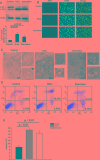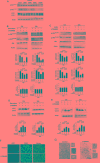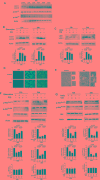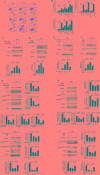H2O2 treatment or serum deprivation induces autophagy and apoptosis in naked mole-rat skin fibroblasts by inhibiting the PI3K/Akt signaling pathway
- PMID: 27863375
- PMCID: PMC5356702
- DOI: 10.18632/oncotarget.13321
H2O2 treatment or serum deprivation induces autophagy and apoptosis in naked mole-rat skin fibroblasts by inhibiting the PI3K/Akt signaling pathway
Erratum in
-
Correction: H2O2 treatment or serum deprivation induces autophagy and apoptosis in naked mole-rat skin fibroblasts by inhibiting the PI3K/Akt signaling pathway.Oncotarget. 2017 Jun 27;8(26):43593-43594. doi: 10.18632/oncotarget.18611. Oncotarget. 2017. PMID: 28672778 Free PMC article. No abstract available.
Abstract
Naked mole-rats (NMR; Heterocephalus glaber) display extreme longevity and resistance to cancer. Here, we examined whether autophagy contributes to the longevity of NMRs by assessing the effects of the PI3K/Akt pathway inhibitor LY294002 and the autophagy inhibitor chloroquine (CQ) on autophagy and apoptosis in NMR skin fibroblasts. Serum starvation, H2O2 treatment, and LY294002 treatment all increased the LC3-II/LC3-I ratio and numbers of double-membraned autophagosomes and autophagic vacuoles, and decreased levels of p70S6K, p-AktSer473, and p-AktThr308. By contrast, CQ treatment decreased p70S6K, AktSer473, and AktThr308 levels. The Bax/Bcl-2 ratio increased after 12 h of exposure to LY294002 or CQ. These data show that inhibiting the Akt pathway promotes autophagy and apoptosis in NMR skin fibroblasts. Furthermore, LY294002 or CQ treatment decreased caspase-3, p53, and HIF1-α levels, suggesting that serum starvation or H2O2 treatment increase autophagy and apoptosis in NMR skin fibroblasts by inhibiting the PI3K/Akt pathway. CQ-induced inhibition of late autophagy stages also prevented Akt activation and induced apoptosis. Finally, the HIF-1α and p53 pathways were involved in serum starvation- or H2O2-induced autophagy in NMR skin fibroblasts.
Keywords: apoptosis; autophagy; naked mole-rats.
Conflict of interest statement
The authors declare no competing financial interests.
Figures




Similar articles
-
Cadmium-induced autophagy promotes survival of rat cerebral cortical neurons by activating class III phosphoinositide 3-kinase/beclin-1/B-cell lymphoma 2 signaling pathways.Mol Med Rep. 2015 Aug;12(2):2912-8. doi: 10.3892/mmr.2015.3755. Epub 2015 May 7. Mol Med Rep. 2015. PMID: 25955216
-
Astragalus Polysaccharide Inhibits Autophagy and Apoptosis from Peroxide-Induced Injury in C2C12 Myoblasts.Cell Biochem Biophys. 2015 Nov;73(2):433-439. doi: 10.1007/s12013-015-0659-8. Cell Biochem Biophys. 2015. PMID: 27352334
-
Morusin induces apoptosis and autophagy via JNK, ERK and PI3K/Akt signaling in human lung carcinoma cells.Chem Biol Interact. 2020 Nov 1;331:109279. doi: 10.1016/j.cbi.2020.109279. Epub 2020 Oct 7. Chem Biol Interact. 2020. PMID: 33035517
-
Learning of nature: The curious case of the naked mole rat.Mech Ageing Dev. 2017 Jun;164:76-81. doi: 10.1016/j.mad.2017.04.010. Epub 2017 May 1. Mech Ageing Dev. 2017. PMID: 28472634 Review.
-
The skin of the naked mole-rat and its resilience against aging and cancer.Mech Ageing Dev. 2023 Dec;216:111887. doi: 10.1016/j.mad.2023.111887. Epub 2023 Nov 21. Mech Ageing Dev. 2023. PMID: 37993056 Review.
Cited by
-
Cell Proliferation Is Strongly Associated with the Treatment Conditions of an ER Stress Inducer New Anti-Melanoma Drug in Melanoma Cell Lines.Biomedicines. 2021 Jan 20;9(2):96. doi: 10.3390/biomedicines9020096. Biomedicines. 2021. PMID: 33498201 Free PMC article.
-
Recent Advances in Carbon and Nitrogen Metabolism in C3 Plants.Int J Mol Sci. 2020 Dec 30;22(1):318. doi: 10.3390/ijms22010318. Int J Mol Sci. 2020. PMID: 33396811 Free PMC article. Review.
-
Suppression of PI3K signaling is linked to autophagy activation and the spatiotemporal induction of the lens organelle free zone.Exp Cell Res. 2022 Mar 15;412(2):113043. doi: 10.1016/j.yexcr.2022.113043. Epub 2022 Jan 29. Exp Cell Res. 2022. PMID: 35101390 Free PMC article.
-
Prognostic association of starvation-induced gene expression in head and neck cancer.Sci Rep. 2021 Sep 27;11(1):19130. doi: 10.1038/s41598-021-98544-1. Sci Rep. 2021. PMID: 34580365 Free PMC article.
-
Alternative Animal Models of Aging Research.Front Mol Biosci. 2021 May 17;8:660959. doi: 10.3389/fmolb.2021.660959. eCollection 2021. Front Mol Biosci. 2021. PMID: 34079817 Free PMC article. Review.
References
-
- Edrey YH, Hanes M, Pinto M, Mele J, Buffenstein R. Successful aging and sustained good health in the naked mole rat: a long-lived mammalian model for biogerontology and biomedical research. ILAR J. 2011;52:41–53. - PubMed
MeSH terms
Substances
LinkOut - more resources
Full Text Sources
Other Literature Sources
Research Materials
Miscellaneous

